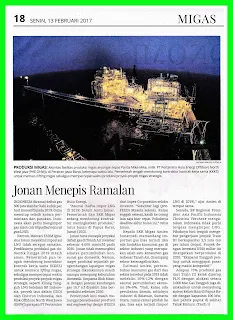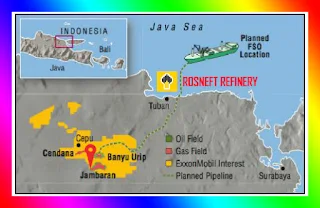Bontang Refinery
Bontang development scheme seems not get a unanimous vote in the internal PT Pertamina. There are differences in views about the scheme and ownership Bontang.
Vice President Corporate Communications of Pertamina Wianda Pusponegoro say, in cooperation with the potential partner in the future, the company will get the majority of the 55% stake in the project Bontang. "It's hard too, if not the majority, and not focus because of this big project," he said.
Just as in Tuban refinery project, the company is partnering with Rosneft acquire a controlling stake of 55%. Wianda also asserted, Bontang will implement the same development schemes Tuban refinery constructed by forming a joint venture (joint venture / JV).
In fact, during a press conference on Friday (30/1), Director of Processing and Petrochemical megaproject Rachmad Hardadi Pertamina estimates, the project is done with the assignment scheme, the company will only acquire a controlling stake (chip-in) 10% -20%, or less than Tuban refinery project.
Hardadi explained, Bontang refinery will be built with the scheme of constructing, operating, switch (build-operate-transfer / BUT) within a certain time. "I was saying from the Bontang counting finance or finance, we could chip in about 10% to 20%," he said at the time.
When reconfirmed, Hardadi Rachmat said the company is still calculating the company's share ownership in development cooperation Bontang.
According to him, it is still finalizing the material for public exposure (public expose). "Still we count, but certainly not the majority share Pertamina [shares]," he said. However, Pertamina is targeting've got a partner in the Bontang refinery project in late April 2017.
Wianda explained, that the company began searching suitable partners for developing projects located in East Kalimantan. The Company is establishing cooperation structures and business management Bontang refinery. In the near future will be held public exposure to companies engaged in the refinery at the end of this month.
GLOBAL COMPANY
Pertamina, he said, will invite more than 37 international companies engaged in the construction of refineries and global financial institutions. Pertamina expects companies interested in the future is a global company that already has experience and a good reputation in the field of building refineries outside the country.
Wianda added that the company did not rule out the seven companies that have participated in the selection of Tuban refinery partners can opt back in. There are several companies that are interested in becoming partners in building the company's Tuban refinery project include Saudi Aramco (Saudi Arabia), Kuwait Petroleum lnternational (Kuwait), Rosneft (Russia), Sinopec (China) and PTT GC & Thai Oil Consortium (Thailand). After going through the selection process, the company finally decided to cooperate with the Russian company, Rosneft.
After the public presentation, the applicants who submitted proposals targeted to appear at the beginning of March so it can proceed with the final selection.
Wianda explain, in the light of the determination of Tuban refinery partners, for the final stage of selection of each Chief Executive Officer (CEO) of the company will meet with President Director of Pertamina to discuss the project in more detail.
If Pertamina has gained partners in April, Tuban refinery project is targeted to be operational in 2023. Operation of Tuban and Bontang refinery in 2023 as well as the revitalization of the refineries exist then no longer need to import fuel oil (BBM). "We are targeting the refinery production could eventually export as part of an international player." Under the project, the total capacity of the oil refineries is expected to rise to 2 million bpd in 2023.
IN INDONESIAN
Kilang Bontang
Lagi-lagi Mengambang
Skema pembangunan Kilang Bontang sepertinya belum mendapatkan suara bulat di internal PT Pertamina. Ada perbedaan pandangan soal skema dan kepemilikan saham Kilang Bontang.
Vice President Corporate Communication Pertamina Wianda Pusponegoro mengatakan, dalam kerja sama dengan calon mitra tersebut nantinya, perseroan akan mendapatkan mayoritas saham yakni 55% dalam proyek Kilang Bontang. “Agak susah juga kalau tidak mayoritas dan tidak fokus karena ini proyek besar,” katanya.
Seperti halnya dalam proyek Kilang Tuban, perseroan yang bermitra dengan Rosneft menguasai saham 55%. Wianda juga menegaskan, Kilang Bontang akan menerapkan skema pembangunan yang sama dengan Kilang Tuban yang dibangun dengan membentuk perusahaan patungan (joint venture/JV).
Padahal, pada saat konferensi pers Jumat (30/1), Direktur Megaproyek Pengolahan dan Petrokimia Pertamina Rachmad Hardadi memperkirakan, dalam proyek yang dikerjakan dengan skema penugasan itu, perseroan hanya akan menguasai saham (chip in) 10%-20% atau lebih kecil dari proyek Kilang Tuban.
Hardadi menjelaskan, Kilang Bontang akan dibangun dengan skema membangun, operasi, alihkan (build operate transfer/BUT) dalam kurun waktu tertentu. "Bontang tadi saya katakan dari hitung-hitungan finance atau keuangan, kita bisa chip in sekitar 10% sampai 20%,” katanya saat itu.
Ketika dikonfirmasi kembali, Rachmad Hardadi mengatakan, saat ini pihaknya masih menghitung kepemilikan saham perseroan dalam kerja sama pembangunan Kilang Bontang.
Menurutnya, saat ini masih dalam tahap finalisasi materi untuk pemaparan publik (public expose). “Masih kami hitung, tetapi yang jelas Pertamina tidak mayoritas share [saham],” katanya. Namun, Pertamina menargetkan sudah mendapatkan mitra dalam proyek Kilang Bontang pada akhir April 2017.
Wianda menjelaskan, saat ini perseroan mulai melakukan pencarian mitra yang cocok untuk mengembangkan proyek yang berlokasi di Kalimantan Timur tersebut. Perseroan sedang menetapkan struktur kerja sama dan bisnis pengelolaan Kilang Bontang. Dalam waktu dekat akan digelar pemaparan publik kepada perusahaan yang bergerak di bidang kilang pada akhir bulan ini.
PERUSAHAAN GLOBAL
Pertamina, menurutnya, akan mengundang lebih dari 37 perusahaan internasional yang bergerak di bidang pembangunan kilang serta institusi keuangan global. Pertamina mengharapkan perusahaan yang berminat nantinya adalah perusahaan global yang sudah memiliki pengalaman dan reputasi yang baik di bidang pembangunan kilang di luar negaranya.
Wianda menambahkan, perseroan tidak menutup kemungkinan tujuh perusahaan yang telah berpartisipasi dalam seleksi mitra Kilang Tuban dapat kembali ikut serta. Ada beberapa perusahaan yang berminat menjadi mitra perseroan dalam membangun proyek Kilang Tuban antara lain Saudi Aramco (Arab Saudi), Kuwait Petroleum lnternational (Kuwait), Rosneft (Rusia), Sinopec (China) serta PTT GC & Thai Oil (Konsorsium Thailand). Setelah melalui proses seleksi, akhirnya perseroan memutuskan untuk bekerja sama dengan perusahaan asal Rusia, Rosneft.
Setelah dilakukan pemaparan publik, peminat yang mengajukan proposal ditargetkan sudah muncul pada awal Maret sehingga bisa dilanjutkan dengan seleksi final.
Wianda menjelaskan, jika berkaca pada penentuan mitra Kilang Tuban, untuk seleksi tahap akhir masing-masing Chief Executive Officer (CEO) dari perusahaan akan bertemu dengan Direktur Utama Pertamina untuk membahas proyek dengan lebih detail.
Jika Pertamina sudah memperoleh mitra pada April, proyek Kilang Tuban ditargetkan sudah beroperasi pada 2023. Pengoperasian Kilang Tuban dan Bontang pada 2023 serta revitalisasi kilang eksis maka tidak perlu lagi impor bahan bakar minyak (BBM). “Kami targetkan produksi kilang nantinya bisa ekspor sebagai bagian dari pemain internasional.” Melalui proyek itu, kapasitas total kilang Pertamina diharapkan bisa naik menjadi 2 juta bph pada 2023.
Bisnis Indonesia, Page-30, Tuesday, Feb, 14, 2017










